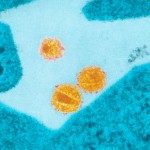Lien vers Pubmed [PMID] – 10825158
J. Biol. Chem. 2000 Aug;275(31):23736-44
CXCR4 is a G-coupled receptor for the stromal cell-derived factor (SDF-1) chemokine, and a CD4-associated human immunodeficiency virus type 1 (HIV-1) coreceptor. These functions were studied in a panel of CXCR4 mutants bearing deletions in the NH(2)-terminal extracellular domain (NT) or substitutions in the NT, the extracellular loops (ECL), or the transmembrane domains (TMs). The coreceptor activity of CXCR4 was markedly impaired by mutations of two Tyr residues in NT (Y7A/Y12A) or at a single Asp residue in ECL2 (D193A), ECL3 (D262A), or TMII (D97N). These acidic residues could engage electrostatical interactions with basic residues of the HIV-1 envelope protein gp120, known to contribute to the selectivity for CXCR4. The ability of CXCR4 mutants to bind SDF-1 and mediate cell signal was consistent with the two-site model of chemokine-receptor interaction. Site I involved in SDF-1 binding but not signaling was located in NT with particular importance of Glu(14) and/or Glu(15) and Tyr(21). Residues required for both SDF-1 binding and signaling, and thus probably part of site II, were identified in ECL2 (Asp(187)), TMII (Asp(97)), and TMVII (Glu(288)). The first residues () of NT also seem required for SDF-1 binding and signaling. A deletion in the third intracellular loop abolished signaling, probably by disrupting the coupling with G proteins. The identification of CXCR4 residues involved in the interaction with both SDF-1 and HIV-1 may account for the signaling activity of gp120 and has implications for the development of antiviral compounds.

